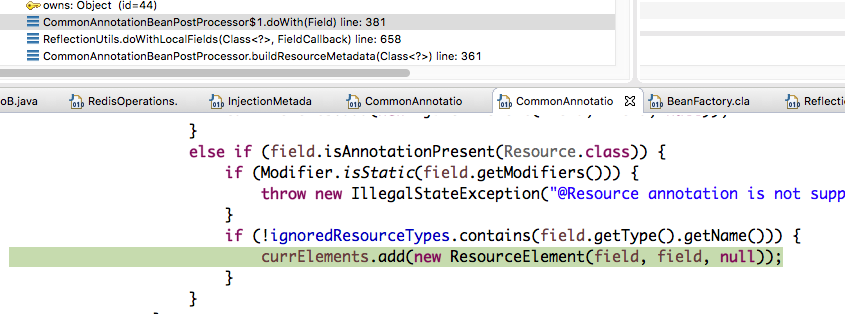blog
使用RedisTemplate的操作类访问Redis
这两天使用了spring提供的redisTemplate类访问redis,本来感觉使用起来没有什么难度,结果当我看官方文档时,被下面一段官方的事例代码搞晕了:
public class Example {
// inject the actual template
@Autowired
private RedisTemplate<String, String> template;
// inject the template as ListOperations
@Resource(name="redisTemplate")
private ListOperations<String, String> listOps;
public void addLink(String userId, URL url) {
listOps.leftPush(userId, url.toExternalForm());
}
}
有些疑问:
- RedisTemplate类注解了有什么用?
- ListOperations为什么不用@Autowired来注解?
Spring的官方文档里没有找到相关说明,只有自己去解惑了。(后续找到再进行补充)
先不说第一个问题,第二个问题好解决。
我们查看ListOperations的具体实现类就可以发现,ListOperations接口只有一个DefaultListOperations的实现类,而且这个类没有提供公有的构造函数,只提供的包级别访问的没有修饰符的构造函数,如下:
class DefaultListOperations<K, V> extends AbstractOperations<K, V> implements ListOperations<K, V> {
DefaultListOperations(RedisTemplate<K, V> template) {
super(template);
}
}
@Autowired注解是Spring通过注解扫描后再反射自动初始化bean的,而此时该类并没有相应的注解,所以如果使用@Autowired来注解,会报如下异常:
Field listOps in sample.data.redis.SampleRedisApplication required a bean of type 'org.springframework.data.redis.core.ListOperations' that could not be found.
那又引出了新问题:
- @Resource这种情况下怎么不会有问题?
- @Autowired和@Resource注解有什么区别?
要解答为何@Resource此时就可以起作用,还需要查看spring的源码。
将断点打在DefaultListOperations类的构造方法上,启动程序,进入断点后,在debug视图中找到void org.springframework.data.redis.core.ListOperationsEditor.setValue(Object value)方法,
public void setValue(Object value) {
if (value instanceof RedisOperations) {
super.setValue(((RedisOperations) value).opsForList());
} else {
throw new java.lang.IllegalArgumentException("Editor supports only conversion of type " + RedisOperations.class);
}
}
该方法中会调用RedisTemplate的opsForList方法将DefaultListOperations初始化,并设置到我们的bean中,那ListOperationsEditor类从哪里来的?还需要往下找。
我们现在找到了这个方法中:

由于刚开始时editor为空,肯定代码会进入findDefaultEditor方法中,
private PropertyEditor findDefaultEditor(Class<?> requiredType) {
PropertyEditor editor = null;
if (requiredType != null) {
// No custom editor -> check BeanWrapperImpl's default editors.
editor = this.propertyEditorRegistry.getDefaultEditor(requiredType);
if (editor == null && String.class != requiredType) {
// No BeanWrapper default editor -> check standard JavaBean editor.
editor = BeanUtils.findEditorByConvention(requiredType);
}
}
return editor;
}
查看注释,如果没有自定义editor,则获取默认的editor,进入PropertyEditor org.springframework.beans.BeanUtils.findEditorByConvention(Class<?> targetType)方法,发现默认的editor寻找逻辑,如下是该方法的部分注释:
Find a JavaBeans PropertyEditor following the 'Editor' suffix convention (e.g. "mypackage.MyDomainClass" -> "mypackage.MyDomainClassEditor").
现在就知道了,因为我们的类型是ListOperations,所以找到了ListOperationsEditor,这是Spring默认提供的editor。 接下来看RedisTemplate类是如何来的。 继续往下找,发现了getBean方法调用,如下:

发现name属性已经是redisTemplate了,还需要再往下找调用的地方,最后找到了InjectionMetadata org.springframework.context.annotation.CommonAnnotationBeanPostProcessor.buildResourceMetadata(Class<?> clazz)中ReflectionUtils.doWithLocalFields中的doWith方法,如下图:
 此时可以看到spring解析了Resource注解,并通过name属性找到对应的bean,也就是redisTemplate了。
此时可以看到spring解析了Resource注解,并通过name属性找到对应的bean,也就是redisTemplate了。
Spring代码大概看完了,现在也就知道了@Autowired和@Resource注解的区别。
通常情况下,两者可以相互替换使用。但@Resource也可以通过类型+Editor方式提供字段的生成方式。
不过话说回来了,redisTemplate类已经提供了opsForList方法获取ListOperations,需要的时候直接获取不就可以了吗?我想我后续是不会这么注解代码的。😄